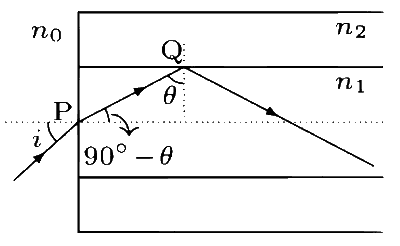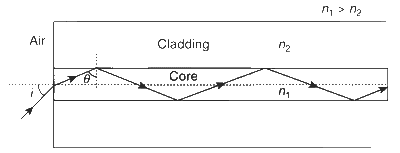JEE Advance - Physics (2015 - Paper 2 Offline - No. 17)
Explanation
Let the whole structure be placed in the medium of refractive index n0. From geometry, if the angle of incidence at Q is $$\theta$$ then the angle of refraction at P is 90$$^\circ$$ $$-$$ $$\theta$$.

The ray will undergo total internal reflection at Q if the angle of incidence at Q is greater than or equal to the critical angle i.e.,
$$\theta$$ $$\ge$$ $$\theta$$c = sin$$-$$1(n2 / n1). ........ (1)
Apply Snell's law for refraction at P to get
n0 sin i = n1 sin(90$$^\circ$$ $$-$$ $$\theta$$) = n1 cos$$\theta$$
= $${n_1}\sqrt {1 - {{\sin }^2}\theta } $$. ...... (2)
From equation (2), the angle of incidence is maximum (i = im) when $$\theta$$ is minimum i.e., when $$\theta$$ = $$\theta$$c (from equation (1)). Thus, the numerical aperture is given by
$$NA = \sin {i_m} = {{{n_1}\sqrt {1 - {{\sin }^2}{\theta _c}} } \over {{n_0}}} = {{\sqrt {n_1^2 - n_2^2} } \over {{n_0}}}$$ ........ (3)
Substitute $${n_1} = \sqrt {45} /4$$ and $${n_2} = 3/2$$ in equation (3) to get the numerical aperture for the structure S1 is
$$N{A_1} = {{\sqrt {45/16 - 9/4} } \over {{n_0}}} = {3 \over {4{n_0}}}$$ ...... (4)
Similarly, substitute n1 = 8/4 and n2 = 7/5 in equation (3) to get the numerical aperture for the structure S2 as
$$N{A_2} = {{\sqrt {64/25 - 49/25} } \over {{n_0}}} = {{\sqrt {15} } \over {5{n_0}}}$$ ...... (5)
In case (A), substitute n0 = 4/3 in equation (4) to get NA1 = 9/16 and substitute n0 = 16/3$$\sqrt15$$ in equation (5) to get NA2 = 9/16.
In case (B), substitute n0 = 6/$$\sqrt15$$ in equation (4) to get NA1 = $$\sqrt15$$/8 and substitute n0 = 4/3 in equation (5) to get NA2 = 3$$\sqrt15$$/20.
In case (C), substitute n0 = 1 in equation (4) to get NA1 = 3/4 and substitute n0 = 4/$$\sqrt15$$ equation (5) to get NA2 = 3/4.
In case (D), substitute n0 = 1 in equation (4) to get NA1 = 3/4 and substitute n0 = 4/3 equation (5) to get NA2 = 3$$\sqrt15$$/20.
Comments (0)



